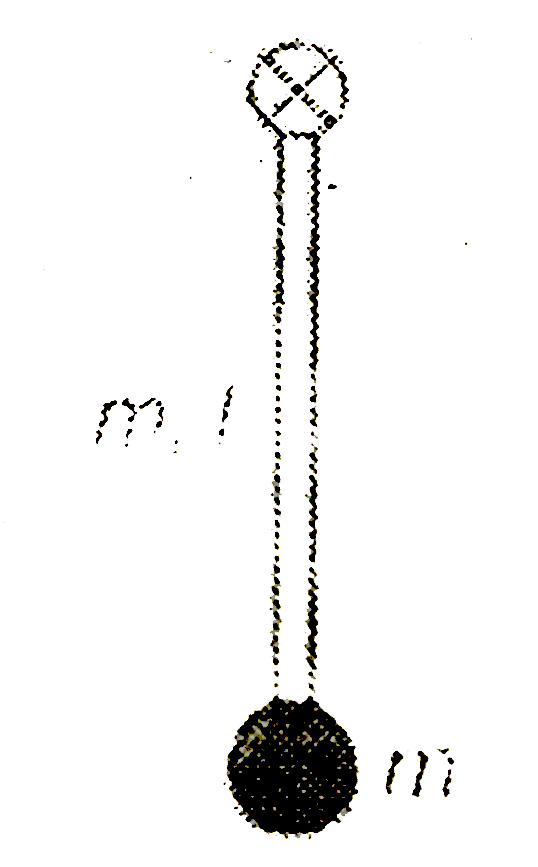A particle is attached to the lower end of a uniform rod which is hinged at its other end as shown in the figure. Another identical particle moving horizontally, collides inelastically and sticks to it. The minimum speed of moving particle so that the rod with particle performs circular motion in a vertical plane will be: [length of the rod is l, consider masses of both particle and rod to be same]
![A particle is attached to the lower end of a uniform rod which is hinged at its other end as shown in the figure. Another identical particle moving horizontally, collides inelastically and sticks to it. The minimum speed of moving particle so that the rod with particle performs circular motion in a vertical plane will be: [length of the rod is l, consider masses of both particle and rod to be same]](https://d10lpgp6xz60nq.cloudfront.net/physics_images/MPP_PHY_C08_E01_127_Q01.png)
√10gl
√20gl
√703gl
√1753gl
The correct Answer is:C
Step by step video & image solution for A particle is attached to the lower end of a uniform rod which is hinged at its other end as shown in the figure. Another identical particle moving horizontally, collides inelastically and sticks to it. The minimum speed of moving particle so that the rod with particle performs circular motion in a vertical plane will be: [length of the rod is l, consider masses of both particle and rod to be same] by Physics experts to help you in doubts & scoring excellent marks in Class 11 exams.
Updated on:21/07/2023Topper's Solved these Questions
- ROTATIONAL MOTIONBOOK - DC PANDEY ENGLISHCHAPTER - ROTATIONAL MOTIONEXERCISE - More than one option is correct
36 Videos
- ROTATIONAL MOTIONBOOK - DC PANDEY ENGLISHCHAPTER - ROTATIONAL MOTIONEXERCISE - Comprehension Type Questions
40 Videos
- ROTATIONAL MOTIONBOOK - DC PANDEY ENGLISHCHAPTER - ROTATIONAL MOTIONEXERCISE - Integer Type Questions
17 Videos
- ROTATIONAL MECHANICSBOOK - DC PANDEY ENGLISHCHAPTER - ROTATIONAL MECHANICSEXERCISE - Subjective Questions
2 Videos
- SEMICONDUCTORS AND ELECTRONIC DEVICESBOOK - DC PANDEY ENGLISHCHAPTER - SEMICONDUCTORS AND ELECTRONIC DEVICESEXERCISE - More than One Option is Correct
3 Videos
Similar Questions
A particle is attached to the lower end of a uniform rod which is hinged at its other end as shown in the figure. Another identical particle moving horizontally, collides inelastically and sticks to it. The minimum speed of moving particle so that the rod with particle performs circular motion in a vertical plane will be: [length of the rod is l, consider masses of both particle and rod to be same]

View SolutionA particle, moving horizontally, collides perpendicularly at one end of a rod having equal mass and placed on a smooth horizontal surface.

View SolutionA uniform rod of mass M1 is hinged at its upper end as shown in the figure . A particle of mass M2 which is moving horizontally, strikes the rod elastically at its midpoint. If the particle comes to rest after collision then the value of M1M2 is

View SolutionA particle is attached to an end of a rigid rod. The other end of the rod is hunged and the rod rotates always remaining horizontal. Its angular speed is increasing at contant rate. The mass of the particle is m . The force exerted by the rod on the particle is →F , then:
View SolutionA uniform rod is resting freely over a smooth horizontal plane. A particle moving horizontally strikes at one end of the rod normally and gets stuck. Then
View SolutionA uniform rod of mass m and length / is hinged at upper end. Rod is free to rotate in vertical plane. A bail of mass m moving horizontally with velocity vo collides at lower end of rod perpendicular to it and sticks to it. The minimum velocity of the ball such that combined system just completes the vertical circle will be
View SolutionTwo particles of masses m and 2m are attached to the massless rod of length 2l as shown in figure. The rod is hinged at its midpoint O and is free to rotate in vertical plane about hinge. The minimum speed v at the given instant so that it can complete the circle.

View SolutionA particle moves in a circular path with a uniform speed. Its motion is
View SolutionA particle of mass m is attached to an end of a uniform rod of mass M = 2m and length l1 which is suspended through its mid point by an inextensible string as shown initially the rod is in horizontal position and at rest. The system is released from this position Just after the release

View SolutionA uniform rod is hinged at its one end and is allowed to rotate in verticle plANE. Rod is given angular velocity ω in its verticle position as shown in figure. The value of ω for the force exerted by the hinge on rod is zero in this position is

View Solution
